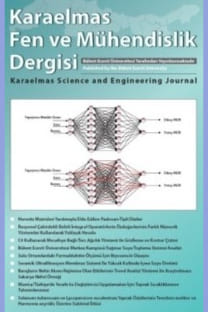Application of Different Methods of Surface Analysis for the Early Diagnosis of Art-Stone Calcarenite Deterioration
Application of Different Methods of Surface Analysis for the Early Diagnosis of Art-Stone Calcarenite Deterioration
calcarenite, surface analysis XRD, XPS, SEM, surface modification, climatic parameters, air pollution,
___
- Adamo, P., Giordano S., Vingiani S., Castaldo Cobianchi R., Violante P. 2003. Trace element accumulation by moss and lichen exposed in bags in the city of Naples (Italy). Environ. Pollut., 122: 91–103.
- Azároff, LV., Kaplow R., Kato N., Weiss RJ., Wilson AJC., Young RA. 1974. X-ray diffraction. McGraw-Hill.
- Bari, A., Rosso A., Minciardi MR., Troiani F., Piervittori R. 2001. Analysis of heavy metals in atmospheric particulates in relation to their bioaccumulation in explanted Pseudevernia furfuracea thalli. Environ. Monit. Assess., 69: 205– 220.
- Bock, E., Sand, W., 1993. The microbiology of masonry biodeterioration. J. Appl. Bacteriol., 74: 503-514.
- Brown, DA., Beveridge TJ., Keevil, CW., Sheriff, BL., 1998. Evaluation of microscopic techniques to observe iron precipitation in natural microbial biofilm. FEMS Microb. Ecol., 26: 297-310.
- Caneva, G., Salvadori, O. 1989. Biodeterioration of stone. In: Larraini, L., Pieper, R. (Eds.), The Deterioration and Conservation of Stone. UNESCO, Paris, 182-234.
- Castle, JE., Salvi, AM. 2001. Chemical state information from the near-peak region of the X- ray photoelectron background. J. Electron Spectrosc., 114-116, 1103-1113, and citations.
- Cecchia, G., Pantania, L., R.aimondi, V., Tomaselli, L., Lamenti, G., Tiano, P., Chiari, R. 2000. Fluorescence lidar technique for the remote sensing of stone monuments. J. Cultur. Herit., 1: 29–36.
- De los Ríos, A., Wierzchos, J., Ascaso, C. 2002. Microhabitats and chemical microenvironments under saxicolous lichens growing on granite. Microb. Ecol., 43:181-188.
- Duran, A., Herrera LK., Jimenez de Haro, MC., Justo, A., Perez-Rodriguez, JL. 2008. Non- destructive analysis of cultural heritage artefacts from Andalusia, Spain, by X-ray diffraction with Gobel mirrors. Talanta, 76. 183–188.
- Goldstein, J. 2003. Scanning electron microscopy and Adacemic/Plenum Publishers, 689 p. Kluwer
- Grant, JT., Briggs, D. (eds). 2003. Surface Analysis by Auger and X-ray Photoelectron Spectroscopy, IM Publications, Chichester, UK.
- Griffin, PS., Indicator, N., Koestler, RJ. 1991. The biodeterioration of stone: a review of deterioration mechanisms, conservation case, histories and treatment. Intern. Biodet., 28: 187- 208.
- Harter, P. 1986. Acidic Deposition - Materials and Health Effects. IEA Coal Research TR36.
- Jozic, M., Peer, T., Türk, R. 2008. The impact of the tunnel exhausts in terms of heavy metals to the surrounding ecosystem. Environ. Monit. Assess., 150: 261–271.
- Kirkitsos, P., Sikiotis, D. 1996. Deterioration of Pentelic marble, Portland limestone and Baumberger sandstone in laboratory exposures to NO2: a comparison with exposures to gaseous HNO3. Atmos. Environ., 30: 941–950.
- Koestler, RJ., Brimblecomb, P., Camuo D., Ginell W., Graedel, T., Leavengood, P., Petushkova, J., Steiger, M., Urzi, C., Verges-Belmin, V., Warscheid, Th. 1994. Group report: How do external environmental factors accelerate change? In: Krumbein W.K., Brimblecombe P., Cosgrove D.E., Staniforth S. (Eds.), Durability and Change. Wiley, Chichester, 149-163.
- Lipfert, FW. 1987. Effects of Acidic deposition on the atmospheric deterioration of materials. Materials Performance, 12, National Association of Corrosion Engineers.
- Lipfert, FW. 1989. Atmospheric damage to calcareous stones: comparison and reconciliation of recent findings. Atmos. Envir., 23: 415-419.
- Lisci, M., Monte, M., Pacini, E. 2003. Lichens and higher plants on stone: a review. Int. Biodet. Biodeg., 51, 1-17
- May, E., Lewis, FJ., Pereira, S., Tayler, S., Seaward, MRD., Allsopp, D. 1993. Microbial deterioration of building stone: a review. Biodet. Abstracts, 7: 109-123. NAPAP, 1990. National programme. Integrated assessment Assessment Report. NAPA, Washington D.C. 1990
- Paine, SG., Linggood, FV., Schimmer, F., Thrupp, TC. 1933. The Relationship of micro-organisms to the decay of stone. Philosophical Transactions of the Royal Society, London, Vol. CCXXII-B486, B: 97-127.
- Papida, S., Murphy, W., May, E. 2000. Enhancement of physical weathering of building stones by microbial populations. Intern. Biodet. & Biodeg., 46: 305-317.
- Piervittori, R., Laccisaglia, A. 1993. Lichens as biodeterioration Aerobiologia, 9: 181-186. and biomonitors.
- Piervittori, R., Salvadori, O., Laccisaglia, A. 1996. Literature on Lichens and biodeterioration of stonework. The Lichenologist, 28: 471-483.
- Schaffer, RJ. 1932. The weathering of natural building stones, in Building Research Special Report, n.18, London.
- Shirakawa, MA., Beech IB., Tapper R., Cincotto MA., Gambale, W. 2003. The development of a method to evaluate bioreceptivity of indoor mortar plastering to fungal growth. Intern. Biodet. & Biodeg., 51: 83-92.
- Sorbo, S., Aprile G., Strumia S., Castaldo, Cobianchi, R., Leone, A., Basile, A. 2008. Trace element acumulation in Pseudevernia furfuracea (L.) Zopf exposed in Italy's so called Triangle of Death. Sci. Total Environ., 407: 647–654.
- Sterflinger, K., Prillinger, H. 2001. Molecular taxonomy and biodiversity of rock fungal communities in an urban environment (Vienna, Austria). Ant. Leeuw, 80: 275-286.
- Strzelczyk, AB. 1981. Microbial biodeterioration: stone. In: Rose, A.H. (Ed.), Economic Microbiology, Vol. 6. Academic Press, London, 62-80.
- Ukberg, K. 1990. The Effects of acid deposition on buildings and building materials. UK Building Effects Review Group. HMSO, London.
- Vingiani, S., Adamo, P., Giordano, S. 2004. Sulphur, nitrogen and carbon content of Sphagnum capillifolium and Pseudevernia furfuracea exposed in bags in the Naples urban area. Environ. Pollut., 129: 145–158.
- Warscheid, T., Braams, J. 2000. Biodeterioration of stone: a review. Intern. Biodet. & Biodeg, 46: 343- 368.
- Welton, RG., Cuthbert, SJ., Mclean, R., Hursthouse, A., Hughes, J. 2003. Preliminary Study of the phycological degradation of natural stone masonry. Geochem. Hlth., 25: 139–145.
- ISSN: 2146-4987
- Yayın Aralığı: 3
- Başlangıç: 2011
- Yayıncı: ZONGULDAK BÜLENT ECEVİT ÜNİVERSİTESİ
Determination of Ion Concentrations and Heavy Metals in the Air Particulates of an Industrial Area
Sabino BUFO, Laura SCRANO, Laura FRADDOSİO-BOCCONE, Fausto LANGERAME, Rocco LAVİANO, Zbigniew ADAMSKİ
Maden Sahasından Kaynaklanan Sızıntı Sularının Maden Çayına Etkisi: I. Ağır Metaller
Murat TOPAL, Işıl Arslan TOPAL
Fitoöstrojenler: Bitkisel Kaynaklı Östrojenik Bileşikler
Nevzat KONAR, Ender Sinan POYRAZOĞLU, Köksal DEMİR, Iraz HASPOLAT, Nevzat ARTIK
